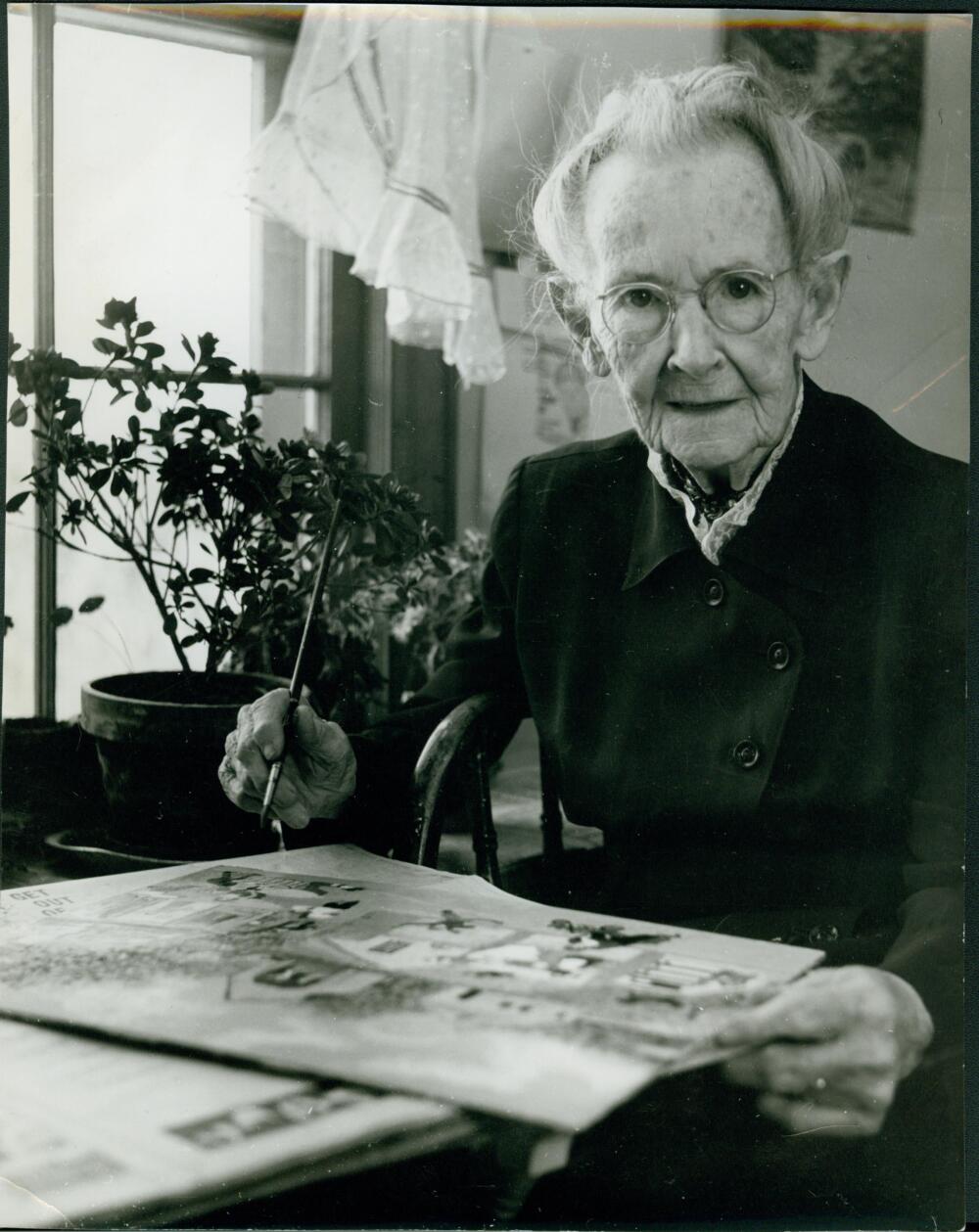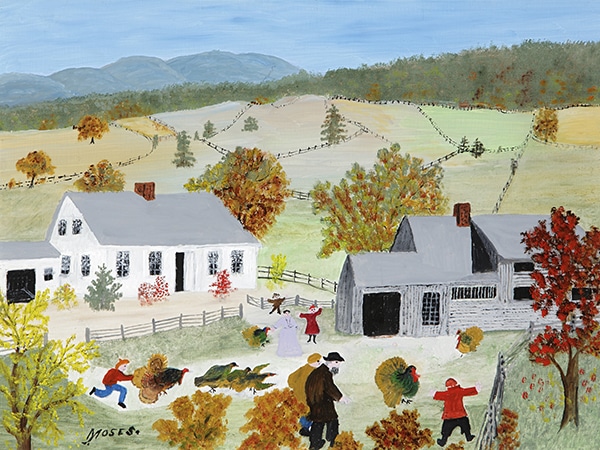For Immediate Release: June 7, 2017
Contact: Susan Strano, Marketing Director
[email protected]
802-447-1571
Grandma Moses: American Modern

Anna Mary Robertson “Grandma” Moses, 1958 Silver Gelatin Print, 8 x 10 inches, Collection of Bennington Museum
So you think you know Grandma Moses? Little old lady who began painting folk pictures of country life at the age of 78 and then became the most famous artist in America. Would you ever associate her name with Modernism? Yet the same people who embraced Modernism in America in the 1930s and 40s were also collecting folk art. It was at this time that curators and collectors began to make connections between what they called the “American Primitives” and the most advanced contemporary art. In fact, the first public exhibition of Grandma Moses’s paintings was held at the Museum of Modern Art in 1939, and was organized by Sidney Janis, who later became famous as the gallerist who represented Abstract Expressionism and Pop Art. Surprising!
Bennington Museum is home to the largest public collection of paintings by Anna Mary Robertson Moses (1860-1961). Better known as Grandma Moses, the artist was catapulted to international fame during the 1940s as the result of her charming, naïvely executed paintings of rural American farm life. But she was so much more than a homespun folk hero. The popular view is that she simply painted scenes remembered from her childhood. In fact, she was a highly skilled artist who refined her art through practice and created a unique world of her own imagining. She combined multiple perspectives in the same painting and used collage and popular imagery, unconsciously paralleling the techniques of Cubism, Surrealism, and Pop Art.
Grandma Moses: American Modern, on view at the Bennington Museum, its final venue, July 1 through November 5, has a subversive goal, for it will upset your expectations and get you to look at this beloved American artist with fresh eyes. It is a long-overdue exhibition that will reestablish her place in the mid-century art world that was embracing modern art at the same time. By putting her paintings side-by-side with works by such iconic Modernists as Joseph Cornell, Helen Frankenthaler, Fernand Léger, and Andy Warhol, and folk artists such as Edward Hicks and Joseph Pickett, the exhibition allows visitors to discover for themselves how all these artists drew on found images, color, collage, memory, and their own innate artistic sensibility to create original masterpieces. Like any trained artist, Moses used thought, planning, and intuition to create works of enormous vitality and imagination.
Memory, Imagination, Clippings, Collages, and Commercialism

Anna Mary Robertson “Grandma” Moses (1860-1961) Catchin’ The Turkey, 1955 Oil on pressed wood, 12 x 16 inches Collection of Bennington Museum Copyright © 2017, Grandma Moses Properties Co. New York
Creating detailed depictions of seasonal activities, Moses came to be especially associated with the Thanksgiving and Christmas holidays. A perfect example of that is Catchin’ The Turkey, 1955. While the finished product feels like a seamless, cohesive whole, Moses’s paintings such as this are actually patchworks of borrowed sources (newspaper and magazine clippings), often pulled completely out of context, and the artist’s own memories and associations. “Moses surely had strong memories of the annual ritual of catching the turkey for her family’s Thanksgiving meal, as she repeated this subject well over a dozen times throughout her career. However, as with all her paintings, what seems like a vividly recalled personal memory is in fact a carefully constructed image ripe with nostalgic associations,” states Jamie Franklin, Curator at the Bennington Museum.
Moses wrote of her painting practice, “I look out the window sometimes to seek the color of the shadows and the different greens in the trees, but when I get ready to paint I just close my eyes and imagine a scene.” Working in a similar fashion, Helen Frankenthaler also held the landscape inside herself and let it pour out, literally in her case, splashing thinned oil paints directly from a coffee can onto a canvas on the floor as she created works such as Silver Coast, 1958. Describing the creation, Frankenthaler recalled, “Though it was painted in her studio, far from the motif, the memory of the landscape is in the painting.”
Moses’s technique of compiling multiple unrelated clippings into distinct new images echoes the practice of Joseph Cornell, another of America’s best-known self-taught artists of the mid-twentieth century, now widely recognized as an important Modernist. In Moses’s Catchin’ the Turkey, the boy running in pinwheel fashion was traced from a figure in John Falter’s Saturday Evening Post cover painting Evening Picnic, where the boy was actually frolicking with other children. Moses had a knack for finding images of figures that powerfully convey abstract visual information via posture and body language. Once found, certain figures would be used multiple times. These images were traced from clippings she kept in a large painted trunk that she would riffle through to find inspiration. Unrelated clippings were assembled to create new images, collages designed in her imagination. “It is impossible to say exactly what percentage of the artist’s paintings are based on her voluminous collection of clippings, but given the surviving evidence it is safe to say that the majority of her figures, animals, buildings and even a large percentage of her landscape elements were directly traced or adapted in some way, shape, or form from pre-existing imagery,” states Franklin.

Joseph Cornell (American, 1903–1972) Untitled, c. 1965 Paper collage on Masonite, 12 1/16 x 9 1/8 inches Williams College Museum of Art, Williamstown, Mass. Gift of Mrs. John A. Benton, 73.28 Art© The Joseph and Robert Cornell Memorial Foundation/Licensed by VAGA, New York, NY
Like Moses, Cornell was astoundingly inventive in his use of found sources, often repurposing a favored image again and again, sometimes decades apart. Cornell kept his source materials of clippings, paper ephemera, and other found materials filed in his basement studio in some 150 loosely categorized, highly personal dossiers. His untitled collage of ca. 1965 shows his habit of melding disparate found materials into highly evocative, surrealist images, this one a landscape populated by birds, a doll, a sculptural figure, and a boat.
“Moses’s painting technique was grounded in a collage aesthetic and she was well versed in needlework of all types. In addition to beginning her artistic career making embroidered pictures, which played a significant role in the development of her iconic painting style, Moses also made pieced quilts and rag dolls. Her painting The Quilting Bee emphasizes the domestic, communal, female-dominated nature of this quintessential nineteenth-century tradition,” states Franklin. Miriam Schapiro was one of the foremost exponents of Femmage, a feminist art movement of the 1970s that involved reviving materials, techniques and processes historically associated with traditional women’s art. Schapiro’s fabric painting Patience, 1976, is a perfect complement to The Quilting Bee, with its fabric ground in a traditional honeycomb quilt pattern centered by a vintage apron, a powerful symbol of women’s domestic servitude that has been collaged to the surface of the image, and the motto “patience” painted above.
As a commercial illustrator in the 1950s, Andy Warhol had the same appetite as Moses for adapting his imagery from popular printed sources. An exhibition of Warhol’s Campbell’s Soup can paintings at Ferus Gallery in Los Angeles in 1962 catapulted the artist to fame in the “fine art” realm and the images went on to become icons of Pop Art. In 1964 he took a reproduction in a photography magazine and adapted it to make Flowers, another icon of Pop Art. “Campbell’s Chicken Noodle Soup is from a portfolio of ten soup can prints Andy Warhol editioned in 1968 and Flowers is from a print edition he made in 1970. Both are screen prints, a commercial process often used for mass production. So they show how he used commercial imagery that was converted into fine art and then back, in a way, to a commercial product again. The same process could be used to describe Moses’s own work and its subsequent public reception. She borrowed from popular commercial imagery, created original paintings based on it, and then the paintings were turned back into commercial products, such as curtains, plates, greeting cards and prints, to be consumed by the masses,” states Franklin.

Andy Warhol (1928-1987) Flowers, 1970 Color screenprint on paper, 38 x 38 inches Williams College Museum of Art, Williamstown, Mass Gift of the Andy Warhol Foundation for the Visual Arts (M.2014.1.2) © 2017 The Andy Warhol Foundation for the Visual Arts, Inc. / Artists Rights Society (ARS), New York
Grandma Moses: American Modern is on view at Bennington Museum, its final venue, July 1 through November 5. The exhibition was organized by Shelburne Museum and Bennington Museum, and combines their two great collections of the painter’s work, supplemented with key loans from private collections arranged by Galerie St. Etienne of New York City. Bennington Museum augments this exhibition with over 20 additional masterpieces on loan from public and private collections on view in the museum’s permanent Grandma Moses Gallery. The result is an almost unprecedented opportunity to see more than 60 works by this colorful American painter throughout three galleries, the largest group of works by Moses assembled in decades.
Grandma Moses: American Modern is accompanied by a scholarly, fully illustrated catalogue that features essays by Jamie Franklin, curator of Bennington Museum, Alexander Nemerov, professor of Art History at Stanford University, Diana Korzenik, professor emerita at the Massachusetts College of Art, and Thomas Denenberg, director of Shelburne Museum. The exhibition at Bennington Museum is generously supported by Bennington Potters and The Bank of Bennington. Our media sponsor is VPR, Vermont Public Radio.
About the Museum
Bennington Museum is located at 75 Main Street (Route 9), Bennington, in The Shires of Vermont. The museum is open daily June through October, 10 am to 5 pm. It is wheelchair accessible. Regular admission is $10 for adults, $9 for seniors and students over 18. Admission is never charged for younger students, museum members, or to visit the museum shop. Visit the museum’s website www.benningtonmuseum.org or call 802-447-1571 for more information.
Bennington Museum is a member of ArtCountry, a consortium of notable art and performance destinations in the scenic northern Berkshires of Massachusetts and southern Green Mountains of Vermont, including The Clark Art Institute, Williams College Museum of Art , Williamstown Theatre Festival (20 minutes away); and MASS MoCA (25minutes away). Visit ArtCountry.org for more information on these five great cultural centers.
